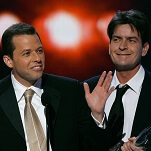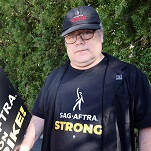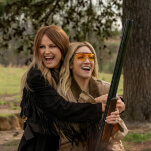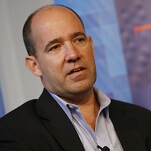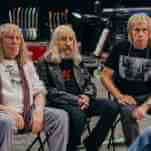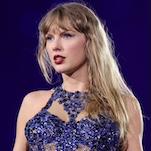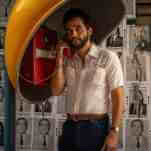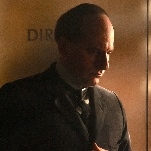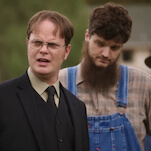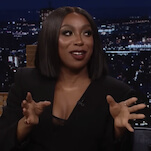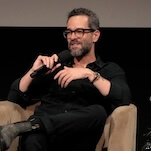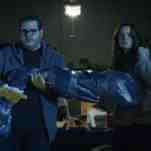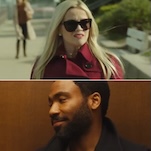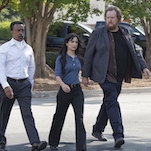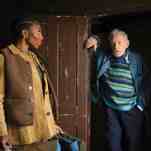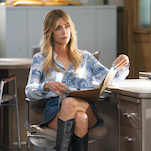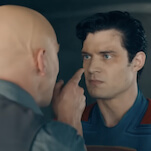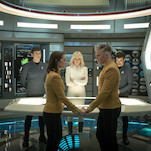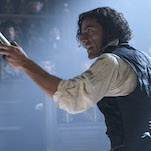And then after most of the bickering has died down and some tears have been shed, a Kleinfeld sales rep fluffs out the bottom of the dress, puts a veil over her hair, and turns the bride-to-be to face the mirror. “Is this the dress?” they ask, with bated breath. Plenty of women walk out of Kleinfeld empty-handed, but once it’s gotten down to the veil-and-rotate-and-question, there’s only one right answer: A breathless “yes,” followed by a lot of squealing.
If this is what female empowerment looks like, it’s incredibly easy to dismiss it as superficial and consumerist. But feminism comes in many forms—and, more importantly, it’s a process, not a destination. It’s just as easy to dismiss another kind of empowerment as conservative and insipid (like the Twilight books) or a third kind as immature or reductive (Taylor Swift). The critiques are all valid—of course they are. But they are trying, and that is more valuable than not trying.
Say Yes To The Dress contains multitudes: It’s superficial in its fixation on dresses and frippery, but it’s broad with its superficiality, which makes it an unexpected cross-section of American society. And the most prized commodity on Say Yes To The Dress is choice—the bride’s choice to be exact. The decision is only a dress, but the store’s fashion director, Randy Fenoli, is adamant that a bride have the opportunity to find the dress that speaks to her—not to her family, her partner, or even, necessarily, to her budget.
It’s not a show without alarming pitfalls. The choice between one wedding dress and another is, obviously, a false one—why a wedding dress? Indeed, why a wedding? The garment is arbitrary, and the tradition is disposable. Marriage rates are in steep decline in the U.S. Say Yes To The Dress has to make a whole host of assumptions just to create their titular choice—between one expensive gown and another.
But while Say Yes To The Dress lives in a fantasy world—where every woman’s dream requires an expensive wedding and a white dress—it also lives in a surprisingly representational, choice-empowered world. Say Yes To The Dress is a show that has a canny understanding of the predicament many women face—which is that choice, especially consumer choice, is often the best way to assert enfranchisement or empowerment. The wedding dress is an arbitrary garment, but it’s an arbitrary garment with meaning. It’s not the dress; it’s the life behind the dress. The match; the wedding; the lifestyle; the family. It’s the dress, and everyone who comes into the bridal salon with her. It’s the dress, and the woman who wears it. And for the women who live in this bubble, either by choice or through tradition (or, realistically, both), Say Yes To The Dress reflects a real decision-making process.
There is little behind this besides good business. Probably because marriage rates are falling, especially for younger, working-class women, the producers are looking for a diverse set of brides with stories to tell—whether that’s a story about an unplanned pregnancy or a car accident. The representation of women is astounding, but the show works to unite all these different women under the same banner: brides. It’s intersectionality with the lofty goal of selling dresses to any and every woman under the sun.
And again, because the show is in the business of selling wedding dresses, Say Yes To The Dress celebrates choice, but that celebration is at least in part just good business—the exploitation of female empowerment for profit, which is a model makeup companies and Sex And The City have, in different ways, perfected. There is no doubt that both Kleinfeld and Say Yes To The Dress are for-profit ventures.
But so is most television. Say Yes To The Dress hardly needs my defense or endorsement—its latest season premiere in February drew record numbers, and the show relies so heavily on repeats that the first night’s draw is just a fraction of total viewership. And its popularity and blatant superficiality is one of the reasons it’s easy to dismiss the show as anything particularly revolutionary. Kleinfeld Bridal is an upscale boutique that feeds directly into the lucrative wedding-industrial complex; a program that encourages women to spend thousands of dollars on dresses does not immediately evoke strong feelings of feminist unity.
Say Yes To The Dress is an example of what you might call “near” feminism: It’s constrained by the status quo and its own desire to make money, but it still finds a way to be about enfranchising women. Which in and of itself is a story most women grapple with—not just whether or not they should be working to empower themselves, because that is a question with a rather obvious answer—but instead how they might go about doing so. The women on Say Yes To The Dress are a surprisingly comprehensive cross-section of society—across classes, ages, religions, and races. And they are all engaged in the process of negotiating between the traditions they were raised with, the people they have chosen to become, and the families that they were born with and have acquired. Nothing about that process is easy.
And that’s something Say Yes To The Dress knows intimately. Because every episode comes down to the same fundamental drama—will the bride get what she wants? Regardless of the story, each woman who comes into the shop faces a host of obstacles: a critical family, a limited budget, time constraints, and the uncanny valley of alterations, just to name a few common pitfalls. Say Yes To The Dress is a show that unabashedly asks—given all those pressures, how can we make that woman happy? The women on the show say yes to their wedding dresses. Say Yes To The Dress says “yes” to its women.
